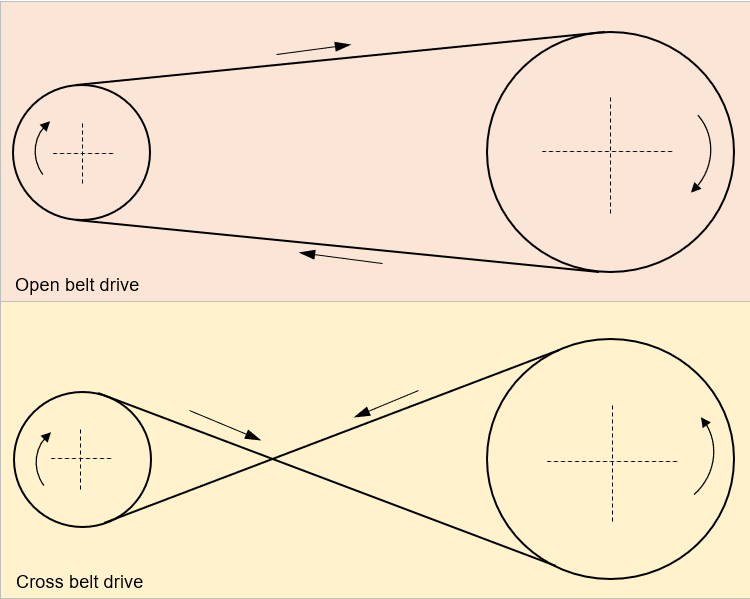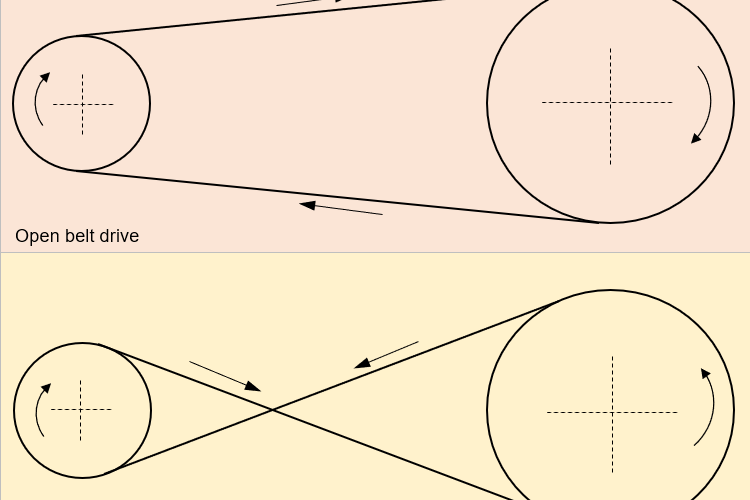Mechanical power transmission system is utilized to transmit mechanical power (in the form of rotational torque) from a driver shaft (such as prime mover) to the driven shaft (like machine unit). Belt drive is one of the mechanical drives (others being gear drive, chain drive and rope drive) that is used to transmit motion, torque and power from one shaft to another. Initially pulleys of required diameter are rigidly mounted on the shafts. An endless belt is wrapped around the pulleys maintaining proper tension to avoid slip. Belt, which passes over the pulleys by partially wrapping it, acts as an intermediate flexible linkage between driver and driven shafts. Friction force between belt and pulley helps transmitting motion and power from one shaft to another. The initial tension applied to the belt as well as frictional characteristic between the mating surfaces determines power transmission capability.
For a fixed speed in driven shaft, diameter of the pulleys determines the velocity ratio and rotational speed of the driver shaft. Flexible belt also helps damping vibration and thereby restricts it from propagating to the driver element. Although it cannot provide constant velocity ratio because of inherent slip, it is very useful for short as well as long distance power transmission. Slip, however, can protect the prime mover from overloading. While velocity ratio and speed of rotation are maintained by the diameter of pulleys for driver and driven shafts, the direction of rotation can be altered by using either open or crossed belt drive. This also influences power transmission capacity due to change in wrap angle between belt and pulley. This classification is mostly applicable for flat belts as V-belts are always used in open configuration.

In an arrangement, where the endless (jointed) belt proceeds from the top of one pulley to the top of another pulley without any crossing, is called open belt drive. Here driven shaft will rotate in same direction as the driver shaft. Moreover, wrap angle is always below 180°, thus power transmission capacity is also low. On the other hand, in cross belt drive, the belt proceeds from the top of one pulley to the bottom of another pulley and thus crosses itself. Here driven shaft rotates in opposite direction to the driver shaft. Wrap angle also increases, which results in higher power transmission capacity. However, continuous rubbing of the belt with itself leads to shorter life and quick failure of the belt. Moreover, it requires comparatively longer belt. Various differences between open belt drive and cross belt drive are given below in table format.
Table: Difference between open belt drive and cross belt drive
| Open Belt Drive | Cross Belt Drive |
|---|---|
| In open belt drive, the belt proceeds from the top of one pulley to the top of another pulley without crossing. | In cross belt drive, the belt proceeds from the top of one pulley to the bottom of another pulley and thus crosses itself. |
| Here the entire belt remains in same plane in every rotation. | Here belt bends in two different planes in every rotation. |
| Here driver and driven shafts rotate in same direction. | Here driver and driven shafts rotate in opposite direction. |
| Angle of wrap or contact angle between belt and pulley is always below 180°. | Angle of wrap is always above 180°. |
| Due to smaller wrap angle, power transmission capability is also lower. | Due to larger wrap angle, power transmission capability is also higher. |
| Length of the belt in open belt arrangement is comparatively shorter. | For same pulley size and centre distance, cross belt drive requires longer belt. |
| Here belt does not touch itself. So no rubbing takes place. Thus belt exhibits longer life. | Due to crossing between two pulleys, belt rubs against itself and thus undergoes gradual wear. Thus belt has shorter life. |
| In between two pulleys, belt vibrates (whips) when centre distance is more. | Cross belt arrangement is free from such vibration. |
Belt configuration: The flexible element in the belt drive can have different shape. A flat belt is a jointed belt having rectangular cross-section, where width is substantially larger than the thickness (height). A V-belt is an endless belt having trapezoidal cross-section with similar width and height. A ribbed belt is similar to flat belt but has teeth in inside circumference that mesh with the corresponding slots on the pulley. The open and cross belt configurations are related to flat belt only. In open belt arrangement, the belt proceeds from the top of one pulley to the top of another pulley without crossing. In close belt arrangement, the belt proceeds from the top of one pulley to the bottom of another pulley and thus crosses itself.
Bending of belt: In open belt configuration, inside portion of the belt touches the pulley; however, no bending or flipping occur as belt proceeds from top of one pulley to the top of another pulley. So belt remains in same plane throughout the rotation. In cross belt drive, belt proceeds from top of one pulley to bottom of another pulley. Since only inside portion of the belt can wrap or touch the pulley, the belt needs to twist 180° between driver and driven shafts. Two such twisting occur for every rotation of the belt.
Direction of rotation: One crucial benefit of belt drive over gear drive is its capability to rotate driver and driven shafts either in same or in opposite direction without using other accessory. In single stage, gear drive can rotate in opposite direction only, unless intermediate or idle gear is employed. An open belt drive can rotate driven shaft in same direction as the driver shaft; whereas, cross belt drive can rotate in opposite direction only. For example, if driver shaft rotates in clockwise direction, the driven shaft will rotate in clockwise direction when pulleys are connected by open belt, else the driven shaft will rotate in counter-clockwise direction when pulleys are connected by cross belt.
Contact angle and power transmission capacity: Belt drive is one friction drive, which indicates motion and power are transmitted by means of friction. Power transmission capacity in flat belt drive relies on coefficient of friction between belt and pulley, angle of wrap, belt velocity and mass of belt per unit length. Higher the wrap angle, more power it can transmit without slip. In open belt drive, this wrap or contact angle between belt and pulley (any one) is always below 180°. It will be equal to 180° if driver and driven pulleys have same diameter (no speed reduction). On the other hand, wrap angle in cross belt drive is always larger than 180°, unless both pulleys have same diameter. Accordingly, cross belt can transmit higher power compared to open belt provided that all other relevant parameters are unchanged.
Length of belt: Length of the belt mainly depends on diameters of driver and driven pulleys and their centre distance. Wrap angle has insignificant influence on belt length. Length of the belt should be maintained properly because a shorter belt can produce immense load on the bearings, whereas a larger belt will increase slip (unstable velocity ratio), fluctuation of force and power loss. For same diameters of driver and driven pulleys and their centre distance, length of cross belt is always more than the length of open belt.
Belt rubbing and service life: In open belt configuration, belt does not touch itself; whereas, in cross belt configuration, belt rubs against itself. Such rubbing generates heat, accelerates wear rate and subsequently reduces service life of the belt. Thus cross belt requires frequent adjustment in tension and quick replacement.
Whipping of belt: Undesired belt vibration perpendicular to the direction of motion is called belt whipping. Belt whipping is one dominating factor in open belt drive, especially when centre distance between driver and driven shafts is more. Belt whipping, together with slip, limits power transmission capability in open belt drives. On the other hand, cross belt drive is inherently free from whipping; however, slip may occur.
Scientific comparison among open belt drive and cross belt drive is presented in this article. The author also suggests you to go through the following references for better understanding of the topic.
- Design of Machine Elements by V. B. Bhandari (Fourth edition; McGraw Hill Education).
- Machine Design by R. L. Norton (Fifth edition; Pearson Education).
- A Textbook of Machine Design by R. S. Khurmi and J. K. Gupta (S. Chand; 2014).


